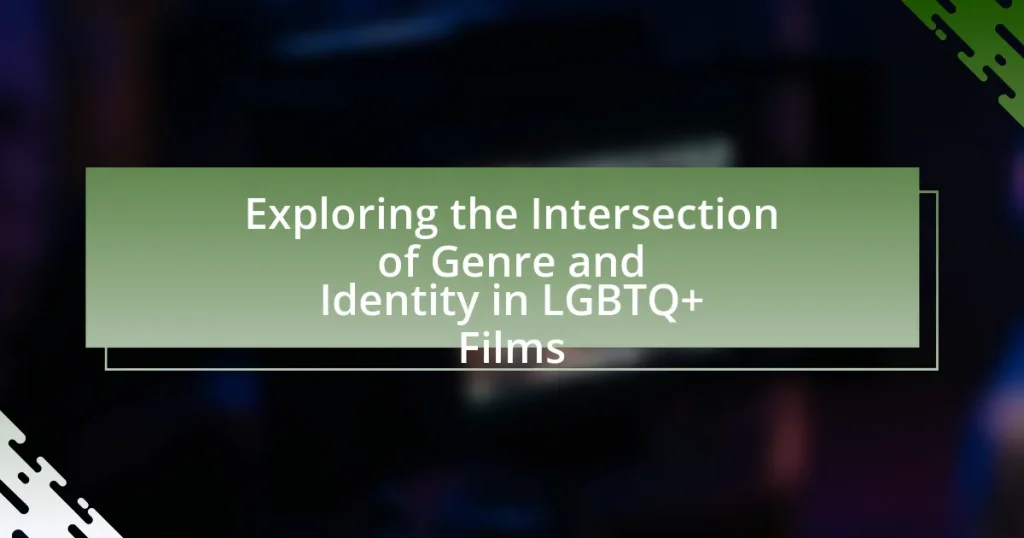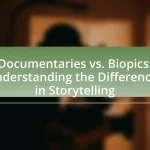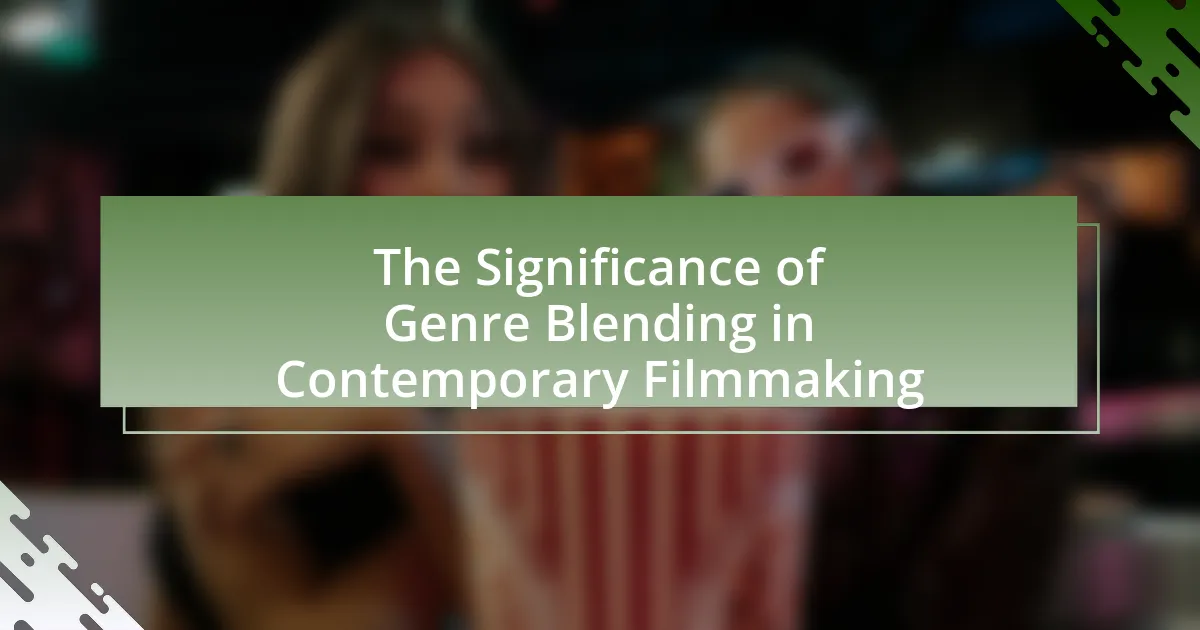The article explores the intersection of genre and identity in LGBTQ+ films, examining how various film genres shape and reflect the experiences of LGBTQ+ individuals. It discusses the influence of genre conventions on storytelling, character development, and thematic exploration, highlighting common genres such as drama, romance, comedy, documentary, and horror. The article also addresses the significance of identity in LGBTQ+ narratives, the representation of intersectionality, and the impact of audience reception on film interpretation. Additionally, it outlines future trends in LGBTQ+ cinema, including the role of technology and social movements in shaping content and representation.

What is the Intersection of Genre and Identity in LGBTQ+ Films?
The intersection of genre and identity in LGBTQ+ films refers to how various film genres shape and reflect the experiences and identities of LGBTQ+ individuals. LGBTQ+ films often utilize genres such as drama, romance, and comedy to explore themes of identity, acceptance, and societal challenges. For instance, the coming-of-age genre frequently portrays the struggles of LGBTQ+ youth in navigating their identities, as seen in films like “Moonlight,” which won the Academy Award for Best Picture in 2017 and highlights the complexities of identity formation within a specific cultural context. Additionally, genre conventions can either reinforce or challenge stereotypes, as seen in the horror genre, where films like “Get Out” use genre tropes to critique racial and sexual identities. This interplay between genre and identity not only provides representation but also fosters a deeper understanding of the diverse experiences within the LGBTQ+ community.
How do genre conventions shape LGBTQ+ narratives?
Genre conventions shape LGBTQ+ narratives by providing frameworks that influence storytelling, character development, and thematic exploration. For instance, romantic comedies often utilize humor and light-heartedness to address LGBTQ+ relationships, making them more accessible to mainstream audiences. In contrast, horror films may employ fear and tension to explore themes of identity and societal rejection, as seen in works like “The Babadook,” which metaphorically addresses queer identity through its narrative structure. These conventions not only guide the portrayal of LGBTQ+ experiences but also reflect and challenge societal norms, as evidenced by the increasing visibility of diverse identities within various genres.
What are the common genres explored in LGBTQ+ films?
Common genres explored in LGBTQ+ films include drama, romance, comedy, documentary, and thriller. These genres often reflect the diverse experiences and identities within the LGBTQ+ community. For instance, drama frequently addresses themes of identity, acceptance, and societal challenges, while romance highlights love stories that transcend traditional norms. Comedy often uses humor to tackle serious issues, making them more accessible. Documentaries provide real-life insights into LGBTQ+ histories and struggles, and thrillers can explore the darker aspects of identity and societal rejection. This genre diversity allows for a multifaceted representation of LGBTQ+ lives and experiences.
How do these genres influence the portrayal of LGBTQ+ identities?
Genres significantly influence the portrayal of LGBTQ+ identities by shaping narrative structures, character development, and thematic elements. For instance, romantic comedies often present LGBTQ+ relationships in a light-hearted manner, normalizing these identities and promoting acceptance, while dramas may explore the struggles and complexities faced by LGBTQ+ individuals, highlighting societal challenges and personal conflicts. Research indicates that the representation of LGBTQ+ characters in various genres can impact audience perceptions; a study by the GLAAD Media Institute found that positive portrayals in mainstream media correlate with increased acceptance of LGBTQ+ individuals in society. Thus, the genre not only dictates the tone and message of LGBTQ+ narratives but also plays a crucial role in shaping public attitudes towards these identities.
Why is identity a crucial element in LGBTQ+ films?
Identity is a crucial element in LGBTQ+ films because it shapes the narratives and character development, reflecting the diverse experiences within the community. LGBTQ+ films often explore themes of self-acceptance, societal acceptance, and the struggles associated with coming out, which are central to the identity of LGBTQ+ individuals. For instance, films like “Moonlight” and “Call Me by Your Name” delve into the complexities of sexual identity and personal growth, illustrating how these elements resonate with audiences. The representation of identity in these films not only fosters understanding and empathy but also challenges stereotypes, contributing to broader societal conversations about diversity and inclusion.
What aspects of identity are commonly represented in these films?
LGBTQ+ films commonly represent aspects of sexual orientation, gender identity, and intersectionality. These films often explore the complexities of being part of the LGBTQ+ community, highlighting the struggles and triumphs associated with different sexual orientations, such as homosexuality, bisexuality, and pansexuality. Gender identity representation includes narratives around transgender and non-binary experiences, showcasing the challenges faced in society. Intersectionality is also a significant aspect, as many films address how race, class, and cultural background intersect with sexual and gender identities, reflecting the diverse experiences within the LGBTQ+ community. For example, films like “Moonlight” and “Paris is Burning” illustrate how these identities interact and shape individual experiences, providing a nuanced portrayal of the LGBTQ+ landscape.
How do filmmakers address intersectionality within LGBTQ+ identities?
Filmmakers address intersectionality within LGBTQ+ identities by creating narratives that reflect the diverse experiences of individuals at the intersections of multiple identities, such as race, gender, and socioeconomic status. For instance, films like “Moonlight” and “The Farewell” explore the complexities of being both LGBTQ+ and a person of color, highlighting how these intersecting identities shape personal experiences and societal challenges. Research indicates that representation of intersectional identities in media can lead to greater visibility and understanding, as seen in studies by the Geena Davis Institute on Gender in Media, which emphasize the importance of diverse storytelling in fostering empathy and awareness.
What role does audience reception play in the intersection of genre and identity?
Audience reception significantly influences the intersection of genre and identity by shaping how narratives are interpreted and valued within LGBTQ+ films. This reception determines the effectiveness of genre conventions in conveying identity themes, as audiences bring their own experiences and cultural contexts to the viewing process. For instance, research by Andrew B. Whitford in “The Queer Cinema of the 1990s” highlights that audience engagement with films like “Paris is Burning” not only reflects but also challenges societal norms, thereby reinforcing or reshaping identities. Consequently, the way audiences receive and respond to genre elements can either validate or marginalize specific identities, illustrating the dynamic interplay between genre, identity, and audience perception.
How do different audiences interpret LGBTQ+ films across genres?
Different audiences interpret LGBTQ+ films across genres through the lens of their own cultural backgrounds, personal experiences, and societal norms. For instance, research indicates that younger viewers often resonate more with coming-of-age narratives, while older audiences may connect with historical or dramatic portrayals of LGBTQ+ lives. A study by the University of Southern California found that 70% of LGBTQ+ viewers prefer films that reflect their own experiences, while heterosexual audiences may interpret these films through a lens of curiosity or empathy, often focusing on the universal themes of love and acceptance. This variance in interpretation highlights how genre influences audience engagement, with comedy often being perceived as more accessible, while horror or drama may evoke deeper emotional responses.
What impact does audience diversity have on film success?
Audience diversity significantly enhances film success by broadening the potential viewer base and increasing box office revenue. Films that resonate with diverse audiences often achieve higher critical acclaim and commercial performance, as they reflect a variety of perspectives and experiences. For instance, a study by the USC Annenberg Inclusion Initiative found that films with diverse casts earned 29% more at the box office compared to those with less diversity. This correlation indicates that inclusive storytelling not only attracts a wider audience but also fosters greater engagement and relatability, ultimately contributing to a film’s overall success.

How do Specific Genres Address LGBTQ+ Identity?
Specific genres address LGBTQ+ identity by incorporating themes, characters, and narratives that reflect the diverse experiences of LGBTQ+ individuals. For instance, romance genres often explore same-sex relationships, highlighting the emotional and societal challenges faced by LGBTQ+ couples, as seen in films like “Call Me by Your Name.” Similarly, horror genres may use metaphorical elements to discuss fear and societal rejection, exemplified by “The Babadook,” which can be interpreted as a representation of queer identity struggles. Documentaries, such as “Paris is Burning,” provide factual accounts of LGBTQ+ lives, showcasing the realities of drag culture and the intersectionality of race and gender. These genre-specific approaches not only validate LGBTQ+ experiences but also foster broader societal understanding and acceptance.
What unique challenges do LGBTQ+ horror films face?
LGBTQ+ horror films face unique challenges primarily due to societal stigma and representation issues. These films often struggle to find mainstream acceptance, as traditional horror narratives may not align with LGBTQ+ experiences, leading to a lack of visibility and funding. Additionally, filmmakers may encounter difficulties in accurately portraying LGBTQ+ identities without resorting to stereotypes, which can alienate audiences. Research indicates that LGBTQ+ representation in horror remains limited, with only a small percentage of films featuring authentic LGBTQ+ characters and narratives, highlighting the ongoing need for more inclusive storytelling in the genre.
How do horror tropes intersect with LGBTQ+ themes?
Horror tropes often intersect with LGBTQ+ themes by utilizing fear, otherness, and subversion of norms to reflect the experiences of marginalized identities. For instance, the trope of the “monster” frequently symbolizes societal rejection faced by LGBTQ+ individuals, as seen in films like “The Babadook,” where the creature represents repressed trauma and identity struggles. Additionally, the final girl trope, traditionally depicting a female survivor, has evolved to include queer characters, challenging heteronormative narratives and allowing for diverse representations of resilience. This intersection is further evidenced by the work of scholars like Barbara Creed, who discusses the “monstrous-feminine” in horror, highlighting how horror can serve as a space for exploring and expressing LGBTQ+ identities.
What are notable examples of LGBTQ+ horror films?
Notable examples of LGBTQ+ horror films include “The Haunting,” “A Nightmare on Elm Street 2: Freddy’s Revenge,” “Hellbent,” “The Babadook,” and “Tigers Are Not Afraid.” “The Haunting,” released in 1963, is often cited for its subtextual exploration of queer themes. “A Nightmare on Elm Street 2: Freddy’s Revenge,” released in 1985, features a protagonist whose struggles with his sexuality are central to the plot. “Hellbent,” released in 2004, is recognized as one of the first slasher films with a gay male lead. “The Babadook,” released in 2014, has been interpreted as an allegory for queer identity and repression. “Tigers Are Not Afraid,” released in 2017, incorporates themes of loss and identity within a supernatural context, resonating with LGBTQ+ experiences. These films illustrate the intersection of horror and LGBTQ+ identity, showcasing diverse narratives within the genre.
In what ways do LGBTQ+ romantic comedies differ from traditional rom-coms?
LGBTQ+ romantic comedies differ from traditional rom-coms primarily in their representation of diverse sexual orientations and gender identities. Traditional rom-coms often center on heterosexual relationships, whereas LGBTQ+ rom-coms explore same-sex relationships and the unique challenges faced by LGBTQ+ individuals, such as societal acceptance and personal identity struggles.
For instance, films like “Love, Simon” and “The Half of It” highlight the complexities of coming out and navigating love in a world that may not always be accepting, which is less commonly addressed in traditional rom-coms. Additionally, LGBTQ+ rom-coms often incorporate themes of community and intersectionality, reflecting a broader spectrum of experiences, as seen in “The Birdcage,” which addresses issues of family dynamics and acceptance. This focus on inclusivity and representation not only broadens the narrative scope but also resonates with audiences seeking authentic portrayals of love and identity.
What themes are prevalent in LGBTQ+ romantic comedies?
Prevalent themes in LGBTQ+ romantic comedies include love and acceptance, identity exploration, and the challenges of societal norms. These films often depict characters navigating their romantic relationships while confronting issues related to their sexual orientation and societal expectations. For instance, the theme of love and acceptance is illustrated in films like “Love, Simon,” where the protagonist seeks acceptance from his family and peers while pursuing a romantic relationship. Identity exploration is another significant theme, as characters often grapple with their sexual identity and the implications it has on their relationships, as seen in “The Half of It.” Additionally, the challenges of societal norms are highlighted through the characters’ experiences with discrimination and the quest for belonging, which are central to the narratives in many LGBTQ+ romantic comedies.
How do these films challenge or reinforce stereotypes?
LGBTQ+ films often challenge stereotypes by presenting complex, multidimensional characters that defy traditional norms associated with gender and sexuality. For instance, films like “Moonlight” and “The Handmaiden” showcase protagonists who navigate their identities in nuanced ways, countering the simplistic portrayals often seen in mainstream media. Conversely, some LGBTQ+ films may reinforce stereotypes by relying on clichés or tropes, such as the flamboyant gay best friend or the tragic queer character, which can perpetuate narrow views of LGBTQ+ experiences. Research indicates that while progressive narratives are on the rise, the persistence of certain stereotypes in film can hinder broader societal acceptance and understanding of LGBTQ+ identities.
How is LGBTQ+ identity represented in documentary films?
LGBTQ+ identity is represented in documentary films through personal narratives, historical context, and social issues affecting the community. Documentaries often feature firsthand accounts from LGBTQ+ individuals, showcasing their experiences, struggles, and triumphs, which humanizes the identity and fosters empathy among viewers. For instance, films like “Paris is Burning” highlight the ballroom culture of the 1980s, illustrating the intersection of race, class, and gender within the LGBTQ+ community. Additionally, documentaries address significant social issues such as discrimination, mental health, and the fight for rights, providing a platform for advocacy and awareness. This representation is crucial as it not only educates audiences but also contributes to the visibility and acceptance of LGBTQ+ identities in society.
What storytelling techniques are used in LGBTQ+ documentaries?
LGBTQ+ documentaries commonly utilize storytelling techniques such as personal narratives, archival footage, and interviews to convey their messages. Personal narratives allow filmmakers to share intimate experiences, fostering emotional connections with the audience. Archival footage provides historical context and authenticity, illustrating the struggles and triumphs of the LGBTQ+ community over time. Interviews with activists, family members, and community leaders offer diverse perspectives, enriching the narrative and highlighting the multifaceted nature of LGBTQ+ identities. These techniques collectively enhance the storytelling by creating a compelling and relatable portrayal of LGBTQ+ lives and issues.
How do documentaries contribute to understanding LGBTQ+ experiences?
Documentaries contribute to understanding LGBTQ+ experiences by providing authentic narratives that highlight personal stories and social issues faced by the community. These films often feature real-life accounts, interviews, and historical context, which help to humanize and contextualize the struggles and triumphs of LGBTQ+ individuals. For example, the documentary “Paris is Burning” explores the ball culture of New York City and sheds light on the lives of LGBTQ+ people of color, illustrating the intersectionality of race, gender, and sexuality. This type of storytelling fosters empathy and awareness, allowing audiences to grasp the complexities of LGBTQ+ identities and experiences.

What are the Future Trends in LGBTQ+ Films?
Future trends in LGBTQ+ films include increased representation of diverse identities, innovative storytelling techniques, and a focus on intersectionality. As audiences demand more authentic narratives, filmmakers are exploring complex characters that reflect a broader spectrum of gender identities and sexual orientations. For instance, the success of films like “Moonlight” and “Portrait of a Lady on Fire” demonstrates a shift towards nuanced portrayals that resonate with both LGBTQ+ and mainstream audiences. Additionally, the rise of streaming platforms has facilitated the production of more niche content, allowing for stories that might not have found a place in traditional cinema. This trend is supported by data showing that films with LGBTQ+ themes have seen a significant increase in box office revenue, indicating a growing market for such narratives.
How is technology influencing the production of LGBTQ+ films?
Technology is significantly influencing the production of LGBTQ+ films by providing accessible tools for filmmakers and expanding distribution channels. The rise of affordable filmmaking equipment, such as high-definition cameras and editing software, allows independent creators to produce high-quality content without substantial financial backing. Additionally, platforms like YouTube, Vimeo, and streaming services enable LGBTQ+ filmmakers to reach wider audiences directly, bypassing traditional gatekeepers in the film industry. For instance, the success of films like “Moonlight,” which won the Academy Award for Best Picture, highlights how technology has facilitated the visibility of LGBTQ+ narratives. Furthermore, social media plays a crucial role in marketing and community engagement, allowing filmmakers to connect with audiences and build support for their projects.
What role do streaming platforms play in LGBTQ+ film visibility?
Streaming platforms significantly enhance LGBTQ+ film visibility by providing a broader and more accessible distribution channel for diverse narratives. These platforms, such as Netflix and Hulu, have dedicated sections for LGBTQ+ content, which increases the likelihood of discovery among audiences. According to a 2021 report by GLAAD, streaming services have become the primary source of LGBTQ+ representation in media, with over 40% of films featuring LGBTQ+ characters available on these platforms. This accessibility allows for a wider audience reach, fostering greater acceptance and understanding of LGBTQ+ stories.
How are filmmakers using new technologies to tell LGBTQ+ stories?
Filmmakers are using new technologies such as virtual reality (VR), augmented reality (AR), and streaming platforms to tell LGBTQ+ stories more effectively. These technologies allow for immersive storytelling experiences that engage audiences on a deeper emotional level. For instance, VR can transport viewers into the narrative, enabling them to experience the perspectives of LGBTQ+ characters firsthand, which enhances empathy and understanding. Additionally, streaming platforms provide greater accessibility and distribution for LGBTQ+ films, allowing diverse voices to reach wider audiences without the constraints of traditional cinema. This shift has been evidenced by the success of films like “Disclosure,” which utilized streaming services to highlight transgender narratives, showcasing the impact of technology on representation in media.
What emerging themes are being explored in contemporary LGBTQ+ cinema?
Contemporary LGBTQ+ cinema is exploring themes such as intersectionality, mental health, and the complexities of identity. Intersectionality examines how various social identities, including race, gender, and sexuality, intersect and impact individual experiences, as seen in films like “The Half of It.” Mental health is increasingly portrayed, highlighting struggles within the LGBTQ+ community, as evidenced by works like “Boy Erased.” Additionally, the complexities of identity are explored through narratives that challenge traditional binaries, such as in “Pose,” which showcases diverse gender identities and experiences. These themes reflect a broader societal conversation about inclusivity and representation in media.
How are global perspectives shaping LGBTQ+ narratives?
Global perspectives are shaping LGBTQ+ narratives by introducing diverse cultural contexts and experiences that enrich storytelling. For instance, films from countries with varying levels of acceptance, such as “Call Me by Your Name” from Italy and “The Handmaiden” from South Korea, showcase how local customs and societal norms influence the portrayal of LGBTQ+ identities. This cross-cultural exchange allows for a broader understanding of the complexities within LGBTQ+ experiences, highlighting issues like colonialism, religion, and social justice. Furthermore, international film festivals increasingly feature LGBTQ+ films from around the world, promoting visibility and dialogue that challenge dominant narratives and foster inclusivity.
What impact do social movements have on LGBTQ+ film content?
Social movements significantly influence LGBTQ+ film content by shaping narratives, representation, and production practices. For instance, the Stonewall Riots of 1969 catalyzed a wave of LGBTQ+ cinema that sought to reflect the struggles and triumphs of the community, leading to films that prioritize authentic representation. Additionally, contemporary movements like Black Lives Matter and Me Too have prompted filmmakers to address intersectionality and social justice within LGBTQ+ narratives, resulting in more diverse and inclusive storytelling. Research indicates that films produced during periods of heightened activism often feature stronger character development and more complex plots, as seen in works like “Moonlight” and “Portrait of a Lady on Fire,” which received critical acclaim for their nuanced portrayals of LGBTQ+ experiences.
What practical tips can filmmakers consider when creating LGBTQ+ films?
Filmmakers creating LGBTQ+ films should prioritize authentic representation by involving LGBTQ+ individuals in the writing, directing, and production processes. This approach ensures that the narratives resonate with genuine experiences and perspectives, enhancing the film’s credibility. Research indicates that films with authentic representation lead to greater audience engagement and acceptance, as seen in the success of films like “Moonlight,” which won the Academy Award for Best Picture in 2017, showcasing the importance of true-to-life storytelling. Additionally, filmmakers should consider the diversity within the LGBTQ+ community, addressing various identities and experiences to avoid stereotypes and promote inclusivity. This can be supported by data from GLAAD’s annual “Where We Are on TV” report, which highlights the increasing visibility of diverse LGBTQ+ characters in media, reflecting societal progress and audience demand for varied narratives.
How can filmmakers ensure authentic representation of LGBTQ+ identities?
Filmmakers can ensure authentic representation of LGBTQ+ identities by involving LGBTQ+ individuals in the creative process, including writing, directing, and casting. This approach allows for genuine perspectives and experiences to shape the narrative, which is crucial for authenticity. Research indicates that films featuring LGBTQ+ characters written by LGBTQ+ creators are more likely to portray nuanced and accurate representations, as seen in works like “Moonlight,” which won the Academy Award for Best Picture and was co-written by Barry Jenkins, an openly gay filmmaker. Additionally, consulting with LGBTQ+ communities during production can provide valuable insights and feedback, further enhancing the authenticity of the portrayal.
What resources are available for aspiring LGBTQ+ filmmakers?
Aspiring LGBTQ+ filmmakers can access a variety of resources designed to support their creative endeavors. Notable organizations include the Outfest Film Festival, which offers mentorship programs and funding opportunities specifically for LGBTQ+ filmmakers. Additionally, the Sundance Institute provides labs and grants aimed at underrepresented voices, including those from the LGBTQ+ community. The GLAAD Media Institute also offers training and resources to help filmmakers effectively tell LGBTQ+ stories. Furthermore, online platforms like FilmFreeway and Withoutabox facilitate submissions to LGBTQ+ film festivals, enhancing visibility and networking opportunities. These resources collectively empower aspiring filmmakers to develop their projects and connect with industry professionals.




